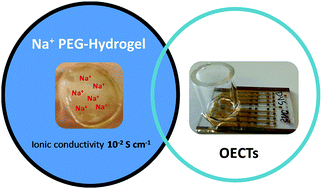A Na+ conducting hydrogel for protection of organic electrochemical transistors†
Abstract
Organic electrochemical transistors (OECTs) are being intensively developed for applications in electronics and biological interfacing. These devices rely on ions injected in a polymer film from an aqueous liquid electrolyte for their operation. However, the development of solid or semi-solid electrolytes are needed for future integration of OECTs into flexible, printed or conformable bioelectronic devices. Here, we present a new polyethylene glycol hydrogel with high Na+ conductivity which is particularly suitable for OECTs. This novel hydrogel was synthesized using cost-effective photopolymerization of poly(ethylene glycol)-dimethacrylate and sodium acrylate. Due to the high water content (83% w/w) and the presence of free Na+, the hydrogel showed high ionic conductivity values at room temperature (10−2 S cm−1) as characterized by electrochemical impedance spectroscopy. OECTs made using this hydrogel as a source of ions showed performance that was equivalent to that of OECTs employing a liquid electrolyte. They also showed improved stability, with only a 3% drop in current after 6 h of operation. This hydrogel paves the way for the replacement of liquid electrolytes in high performance OECTs bringing about advantages in terms of device integration and protection.



 Please wait while we load your content...
Please wait while we load your content...